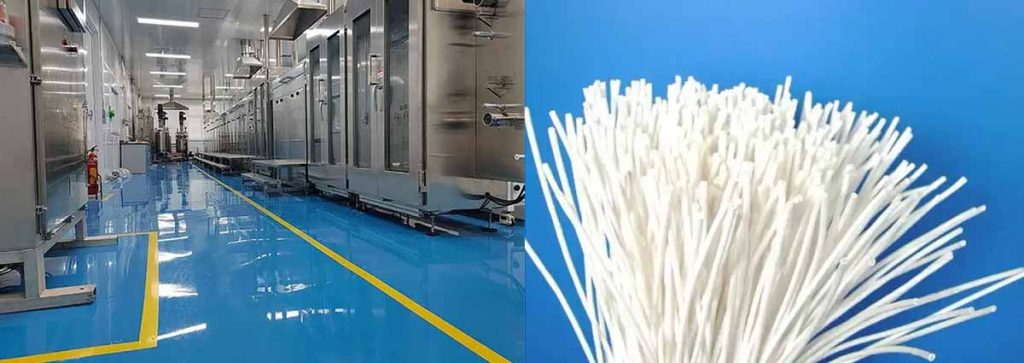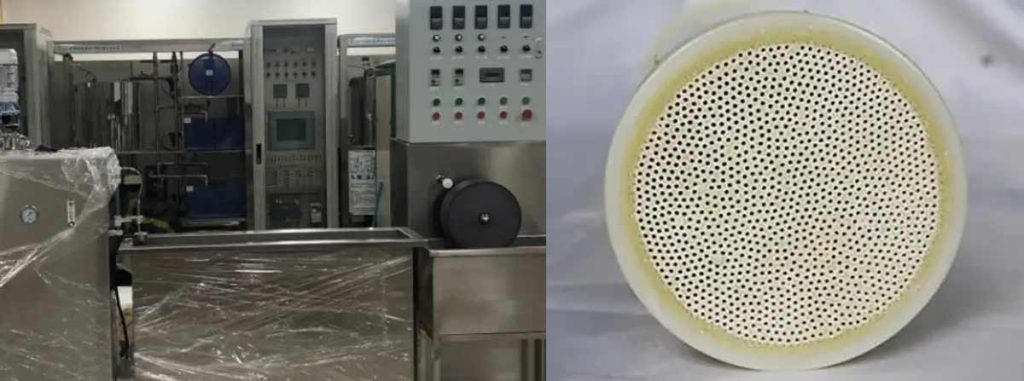

Hollow fiber membrane water filter cartridge holds immense promise for medical applications. The advanced filtering capabilities make the highly effective in removing harmful contaminants, ensuring safer environments in healthcare settings. For instance, studies show their ability to reduce total coliforms by 0.86 log, fecal coliforms by 1.14 log, and Escherichia coli by 0.79 log. These results showcase their potential to minimize waterborne infections and support critical medical processes. However, understanding their operational benefits, associated risks, and necessary precautions remains crucial for safe and effective use.
Key Takeaways
- Hollow fiber membranes clean water by removing harmful substances for medical use.
- Checking and replacing filters on time keeps water clean and safe.
- Training staff to use and care for filters makes them work better.
- Following cleaning rules helps stop infections and keeps patients safe.
- Cleaning and watching for problems with membranes make filters last longer.
Overview of Hollow Fiber Membrane Technology
What Are Hollow Fiber Membranes?
Hollow fiber membranes are advanced filtration materials designed for high-efficiency separation processes. These membranes consist of tiny, cylindrical fibers with hollow cores, resembling microscopic straws. Their structure allows water or other fluids to flow through the inner core while contaminants are trapped on the outer surface. The composition and preparation methods of these membranes significantly influence their properties. For instance, research on PEEK hollow fiber membranes highlights how heat treatment affects pore size and permeability. Lower annealing temperatures result in smaller pores and reduced permeability, while higher temperatures create larger pores with enhanced filtration capabilities. This adaptability makes hollow fiber membranes suitable for diverse applications, including medical use.
How Do They Filter Water?
Hollow fiber membranes filter water through a process called microfiltration or ultrafiltration. The membranes contain tiny pores that allow only substances smaller than their size to pass through. This mechanism effectively removes organic matter, microorganisms, and other impurities. Their high surface area, which can reach hundreds of square meters per gram, enhances separation performance. Additionally, these membranes operate under low pressure, typically below 1 bar, reducing energy consumption. The combination of high efficiency and low operational costs makes hollow fiber membrane water filter cartridges ideal for medical settings, where clean water is essential for patient safety.
| Aspect | Description |
|---|---|
| Pore Size | Membranes have tiny pores that allow only substances smaller than their size to pass through. |
| Surface Area | Can be up to hundreds of square meters per gram, enhancing separation performance. |
| Operating Pressure | Typically operates below 1 bar, leading to reduced energy consumption. |
| Filtration Type | Commonly used for microfiltration and ultrafiltration, effectively removing organic matter and microorganisms. |
Role of Hollow Fiber Spinning Machine in Production
The hollow fiber spinning machine plays a crucial role in the production of these membranes. This specialized equipment extrudes polymer solutions into fine fibers, ensuring uniformity and precision in their structure. The spinning process determines the fiber’s dimensions, pore characteristics, and overall performance. Hollow fiber spinning machine allows manufacturers to control variables such as temperature, pressure, and polymer composition, tailoring the membranes for specific applications. In medical use, this precision ensures the reliability and effectiveness of hollow fiber membrane water filter cartridge, which is essential for infection control and sterilization processes.
Medical Applications and Possibilities
Dialysis and Blood Filtration
Hollow fiber membrane water filter cartridge plays a vital role in dialysis and blood filtration. These cartridges are integral to hemodialysis systems, where they help remove waste products, toxins, and excess fluids from the blood. Their high surface area and precise pore size enable efficient solute transport, making them ideal for this application.
Clinical studies highlight their effectiveness in improving dialysis outcomes. For example:
| Study Focus | Findings |
|---|---|
| Push-pull hemodiafiltration mechanism | Enhanced blood purification outcomes through convective solute removal and protein washout. |
| Performance of dialyzer | Improved solute transport and clearance rates due to alternating flow across hollow-fiber membranes. |
| Drawbacks | Need for disposable blood reservoir and challenges in maintaining trans-membrane pressure (TMP). |
Additionally, research shows that increasing the membrane area and optimizing water permeability can significantly enhance solute clearance rates. Urease-immobilized dialyzers, for instance, have demonstrated double the urea removal efficiency compared to standard dialyzers. These advancements reduce dialysis time and improve patient outcomes.
Sterilization of Medical Equipment
Sterilization is a critical process in healthcare, and hollow fiber membrane water filter cartridge contributes significantly to this effort. The cartridge is used in sterile filtration systems to remove microorganisms and viruses from water and other fluids. The ability to achieve high levels of filtration ensures the safety of medical equipment and supplies.
Different types of filters demonstrate varying levels of efficiency in sterilization:
| Filter Type | Application | Virus Removal Efficiency (LRV) |
|---|---|---|
| Planova Filters | Blood products | Effective (LRV > 4) |
| Cellulose-based Filters | Sterile filtration | Not effective against viruses |
| Mixed Cellulose Ester Filters | Virus ultrafiltration | Varies based on pore size |
Planova filters, for example, have been used to address blood contamination by HIV and hepatitis viruses, achieving significant viral clearance. These filters also complement other sterilization methods, enhancing overall infection control in healthcare settings.
Infection Control in Healthcare
Hollow fiber membrane water filter cartridge is essential for infection control in hospitals and clinics. The cartridge helps prevent the spread of waterborne pathogens, which can cause severe infections in vulnerable patients. By removing bacteria, viruses, and other contaminants, these cartridges ensure the availability of clean water for medical procedures.
Studies show that filtration systems incorporating hollow fiber membranes can achieve high levels of microbial removal. For instance:
- Planova filters effectively clear viruses from blood products, reducing the risk of transfusion-related infections.
- Filtration systems complement chemical disinfection methods, providing an additional layer of protection against pathogens.
The use of these cartridges in infection control protocols underscores their importance in maintaining a safe healthcare environment. Their reliability and efficiency make them indispensable in modern medical practices.

Precautions and Challenges
Risk of Membrane Fouling
Membrane fouling presents a significant challenge in the use of hollow fiber membrane water filter cartridge. Fouling occurs when contaminants accumulate on the membrane surface or within its pores, reducing filtration efficiency and increasing operational costs. This issue can arise from various sources, including organic matter, biofilm formation, and mineral scaling. In medical settings, fouling not only compromises water quality but also poses risks to patient safety by potentially harboring harmful microorganisms.
To mitigate fouling, healthcare facilities must adopt proactive measures. Regular monitoring of membrane performance, such as tracking pressure drops and flow rates, helps detect early signs of fouling. Additionally, combining physical and chemical cleaning methods can restore membrane functionality. For instance, air scouring and backwashing effectively remove reversible fouling, while chemical cleaning addresses more persistent deposits. Implementing these strategies ensures the long-term reliability of the filtration system.
Maintenance and Cleaning Protocols
Proper maintenance and cleaning protocols are essential for the effective operation of hollow fiber membrane water filter cartridge. Neglecting these practices can lead to reduced filtration efficiency, increased energy consumption, and higher replacement costs. Healthcare facilities must establish a routine maintenance schedule to prevent these issues.
The following table highlights common cleaning methods and their effectiveness:
| Cleaning Method | Description | Effectiveness |
|---|---|---|
| Chemical Cleaning | Involves using acids, bases, and oxidants to remove irreversible fouling. | Proper optimization reduces energy consumption and chemical use. |
| Air Scouring | Uses air bubbles to enhance cross-flow velocity and remove reversible fouling. | Highest effectiveness in reducing fouling when combined with other methods. |
| Backwashing | Pumps water backward through the membrane to dislodge particles. | Effective when combined with relaxation techniques for optimal fouling control. |
| Relaxation | Temporarily halts filtration while air scouring continues. | Works best in conjunction with air scouring and backwashing for fouling reduction. |
Combining these methods ensures comprehensive cleaning and extends the lifespan of the cartridges. For example, air scouring and relaxation techniques work synergistically to reduce fouling, while chemical cleaning optimizes performance by targeting stubborn deposits. Staff training on these protocols further enhances the effectiveness of maintenance efforts.
Compliance with Medical Standards
Compliance with medical standards is critical for the safe use of hollow fiber membrane water filter cartridge in healthcare settings. Regulatory bodies, such as the FDA and ISO, establish stringent guidelines to ensure the sterility and safety of medical filtration systems. These standards address bacteriologic purity, microbiologic quality, and performance under actual use conditions.
The table below outlines key compliance requirements:
| Evidence Description | Compliance Requirement |
|---|---|
| Bacteriologic purity of substitution fluid must meet specifications | Compliance with USP and ISO standards for sterility assurance level of 10−6 |
| Bench testing recommendations by FDA | Show that substitution fluid meets USP sterile water for injection standards |
| Clinical testing needed for actual use conditions | Compliance with microbiologic quality standards for USP Sterile Water for Injection |
Additionally, products like Nephros infection control filters meet FDA Class II requirements and retain microbiological contaminants through size exclusion. These certifications demonstrate the reliability of hollow fiber membrane technology in medical applications. Healthcare providers must verify that their filtration systems meet these standards to ensure patient safety and regulatory compliance.
Best Practices for Safe Use
Regular Cartridge Inspection and Replacement
Routine inspection of hollow fiber membrane water filter cartridge ensures the optimal performance. Healthcare facilities should establish a schedule for checking cartridges for signs of wear, clogging, or damage. Visual inspections can identify physical defects, while performance tests can detect reduced filtration efficiency. Replacing cartridges at regular intervals prevents contamination risks and maintains water quality.
A simple checklist can help staff monitor cartridge condition:
- Inspect for physical damage: Cracks or tears in the membrane.
- Evaluate filtration performance: Measure flow rates and pressure drops.
- Replace cartridges: Follow manufacturer recommendations for replacement frequency.
Proactive replacement minimizes downtime and ensures patient safety. Facilities should maintain a log of inspections and replacements to track cartridge usage effectively.
Staff Training on Proper Usage
Proper training equips healthcare staff with the knowledge to use hollow fiber membrane water filter cartridge safely. Training programs should cover installation, operation, and maintenance procedures. Staff should learn to identify common issues, such as membrane fouling, and apply appropriate cleaning methods.
Interactive workshops and hands-on demonstrations enhance understanding. For example:
Tip: Role-playing scenarios can simulate real-world challenges, helping staff practice troubleshooting techniques.
Training should also emphasize the importance of adhering to medical standards and protocols. Well-trained staff reduce the risk of errors and ensure the filtration system operates efficiently.
Adherence to Sterilization Guidelines

Sterilization guidelines ensure the safe use of hollow fiber membrane water filter cartridge in medical environments. Healthcare facilities must follow regulatory standards, such as those set by the FDA and ISO, to maintain sterility and prevent contamination.
Key practices include:
- Pre-use sterilization: Ensure cartridges meet sterility requirements before installation.
- Post-use cleaning: Apply approved cleaning methods to remove residual contaminants.
- Documentation: Record sterilization procedures for compliance audits.
Note: Using certified cartridges that meet medical standards reduces the risk of infection and ensures regulatory compliance.
By adhering to these guidelines, healthcare providers can maintain a safe and sterile environment for patients and staff.
Conclusion
Hollow fiber membrane water filter cartridge offers significant advantages in medical applications. The ability to ensure clean water and support infection control highlights their importance in healthcare. Addressing risks like membrane fouling and adhering to maintenance protocols ensures their effectiveness.
Tip: Regular inspections, proper staff training, and compliance with sterilization guidelines enhance safety and performance.
Healthcare professionals should prioritize these practices to maximize the benefits of this technology. By doing so, they can maintain high standards of patient care and operational efficiency.
